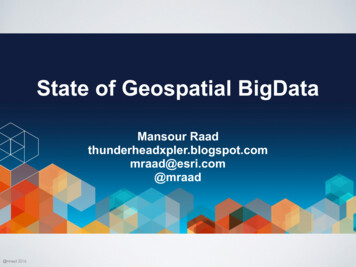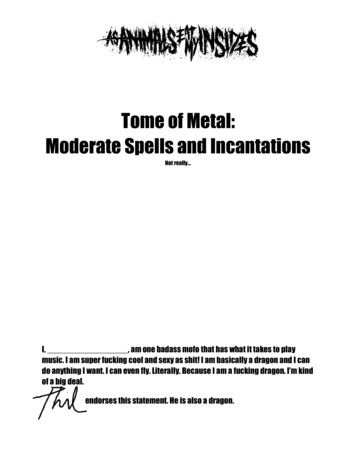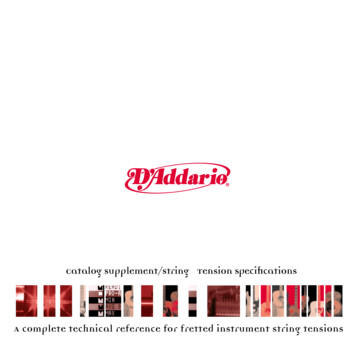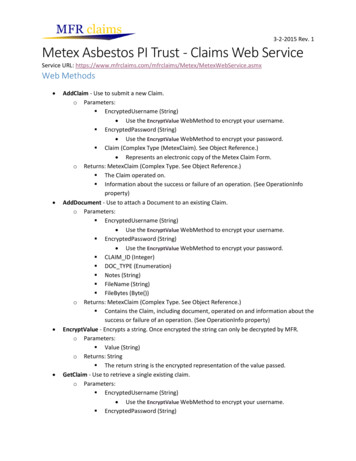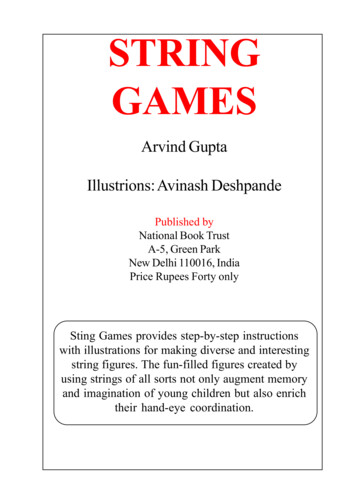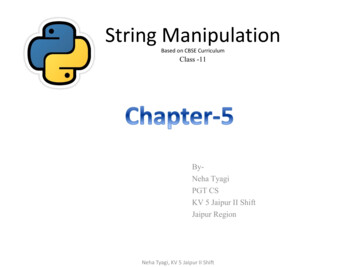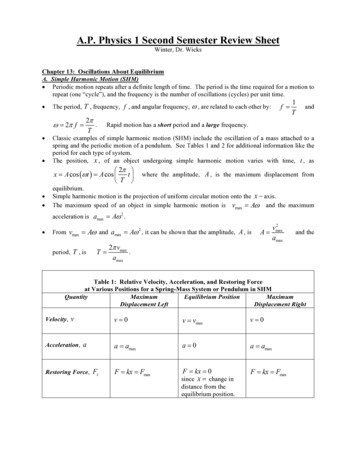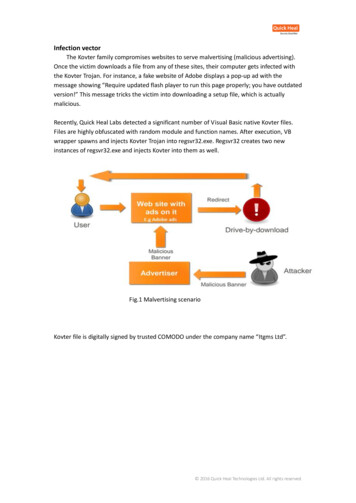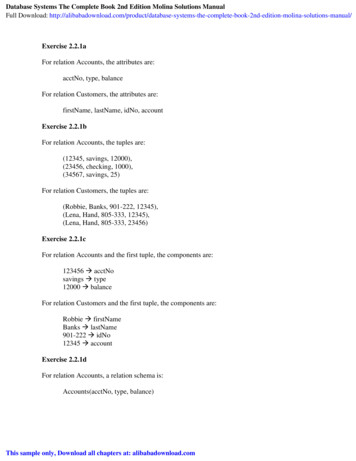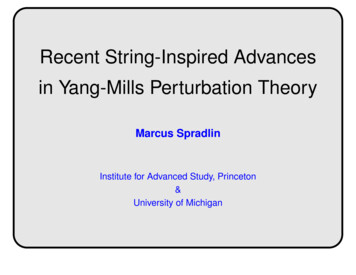
Transcription
Recent String-Inspired Advancesin Yang-Mills Perturbation TheoryMarcus SpradlinInstitute for Advanced Study, Princeton&University of Michigan
OutlineThis talk will be about gluon scattering amplitudes in QCD andsupersymmetric gauge theories. These are notoriously difficultto compute, even at tree-level, so this is fertile ground for newinsights and methods. Even esoteric ideas from string theoryare welcome in this game, as long as they work!Part 1: A review of some of the exciting progress at tree-leveland one-loop which has followed Witten’s discovery of rich mathematical structure hidden in these amplitudes [Witten (12/03)].Part 2: New techniques for exploring the structure of multiloopamplitudes [Cachazo, M.S., Volovich (01/06, and to appear)].OutlinePage 2
Broad Goals of this Research ProgramExplore the hidden mathematical structure in perturbative gaugetheory, andExploit that structure to help make previously impossible calculations possible (in some cases, not just possible but trivial).Generally, we begin with supersymmetric gauge theories, wherethe structure is simplest and new ideas are easiest to explore.Most of the techniques I will describe can be applied, with someeffort, to other theories, including honest QCD.At tree-level there is no distinction: tree-level gluon amplitudesin QCD are secretly supersymmetric. One-loop QCD amplitudes can be naturally split into a supersymmetric part and anon-supersymmetric part.OutlinePage 3
Tree LevelWhy, in the 21st century, do we still find it useful to study tree amplitudes? Even just two years ago, few useful closed form expressions were known. Compact explicit formulas are better than numerical algorithms or recursion relations for currents. Tree-level amplitudes form the basic building blocks of loop amplitudesthrough unitarity ,Im A1 loop XZAtree Atree . A better understanding of the mathematical structure of tree-level amplitudes will guide us as we attack more complicated loop amplitudes.Tree Level Gluon Amplitudes in QCDPage 4
Twistor String TheoryMany recent advances have been made following Witten’s conjecture thatYang-Mills theory (at least at tree-level) admits a description in terms of atwistor string theory.The best evidence in favor of the existence oftwistor string theory is a mysterious formula, derived from string theory, whichrecasts the problem of calculating any tree-level n-gluon scattering amplitude into the problem of solving some polynomial equations. [Roiban, M.S.,Volovich (03/04)].p4···p34 4 i(2π) δ (p2p1Xpi )Xxj :fi (xj ,p) 01det( fi / xj )pnTree Level Gluon Amplitudes in QCDPage 5
In twistor string theory, amplitudes are calculated by an integral over certaininstantons, which are identified with curves in supersymmetric twistor space.These curves can be connected or disconnected,Our calculation was based on the former, but the latter were used to derive amore computationally useful formula [Cachazo, Svřcek, Witten (03/05)]. other decompositions Fantastic, but not yet the end of the story.Tree Level Gluon Amplitudes in QCDPage 6
Consider the six-particle amplitude A(1 , 2 , 3 , 4 , 5 , 6 ). Instead of summing 220 Feynman diagrams [Berends & Giele (1987)], [Mangano, Parke, Xu(1988)], we can write down the answer with just 6 CSW diagrams:2 3 1 461[1 2]3[η 3]3 5 similar terms,[2 η][η 6][6 1] (p3 p4 p5 )2 [3 4][4 5][5 η] 5but a slightly more compact formula is [Roiban, M.S., Volovich (12/04)]2 3 1 46 h1 2 3 4]3(p2 p3 p4 )2 [2 3][3 4]h5 6ih6 1i[2 3 4 5i5[6 1 2 3i3. (p6 p1 p2 )2 [2 1][1 6]h5 4ih4 3i[2 1 6 5iTree Level Gluon Amplitudes in QCDPage 7
The eight-particle amplitude A(1 , 2 , 3 , 4 , 5 , 6 , 7 , 8 ) would require34,300 Feynman diagrams (probably never seriously attempted), or 44 CSWdiagrams: 1[η 8]3hη 4i3[8 1][1 2][2 3][3 η] (p8 p1 p2 p3 )2 h4 5ih5 6ih6 7ih7 ηi 43 similar termsAgain in this case there is a simpler formula (originally discovered “accidentally” [Roiban, M.S., Volovich (12/04)]) [5 4 3 2 1i3(p2 p3 p4 p5 )2 [2 3][3 4][4 5]h6 7ih7 8ih8 1i[2 3 4 5 6i 5 similar termsTree Level Gluon Amplitudes in QCDPage 8
On-Shell RecursionWhere did these simple formulas come from? They were an unexpectedbyproduct of one-loop amplitudes, whose infrared singularities are known ongeneral grounds to be proportional to tree amplitudes.The general structure of these infrared singularities indicated [Roiban, M.S.,Volovich (12/04)] that tree amplitudes should satisfy a quadratic on-shellrecursion relation.Indeed, a precise recursion relation of the form1An Ar 1 2 An 1 rprr 2n 2X(1)was formulated and directly proven in [Britto, Cachazo, Feng (12/04) & withWitten (01/05)].Tree Level Gluon Amplitudes in QCDPage 9
Zigzag DiagramsOn-shell recursion relations are great, but explicit solutions are even better.The BCFW recursion relation admits a closed form solution for ‘split helicity’amplitudes [Britto, Feng, Roiban, M.S., Volovich (03/05)].The amplitude A(1 , · · · , p , (q 1) , · · · , n ) is given by a sum over all‘zigzag diagrams’, of an expression which is trivial to write down32q 21qa2a1q 1a3 2Pq,bPb21b4b3nn 1b21hq Pq,b1 Pb1 1,a1 Pa1 1,b2 ···Pb4 1,1 1i3Pa2 1,b ···Pb2 1,1 [q 1 Pq,b1 b1 ihb1 1 Pb1 1,a1 a1 ] 1,a1124q 1b1q 24 b4 1i[a1 a1 1]···[a3 a3 1] hb1 b1 1i···hbhq q 1i···hn 1i[2 3]···[q 2 q 1]Zigzag diagrams are gauge invariant and a single zigzag diagram can encapsulate thousands or billions of individual Feynman diagrams.Tree Level Gluon Amplitudes in QCDPage 10
Tree Level—SolvedAs promised, the tree-level techniques have been widely applied:CSW rules: for gluons with fermions and scalars [Georgiou, Khoze 04/04], [Wu, Zhu 06/04], for amplitudes with quarks [Georgiou, Glover, Khoze 07/04], [Su, Wu 07/04], for Higgs plus partons [Dixon, Glover, Khoze 11/04], [Badger, Glover, Khoze 12/04], and for electroweak vector boson currents [Bern, Forde, Kosower, Mastrolia 12/04].On-shell recursion relations: for amplitudes with gluons and fermions [Luo, Wen 01/05, 02/05], and for massive particles [Badger, Glover, Khoze, Svřcek 04/05], and for graviton amplitudes [Bedford, Brandhuber, Spence, Travaglini 02/05], [Cachazo,Svřcek 02/05].Tree Level Gluon Amplitudes in QCDPage 11
One LoopOne-loop gluon amplitudes admit the decomposition 1scalarAQCD AN 4 4AN.chiral AI will discuss only the first term, AN 4 , and provide references for the impressive progress that has been made on the other two terms.One Loop Gluon AmplitudesPage 12
Organizing Principle: Integral BasisIn the N 4 theory, all integrals which appear in any Feynman diagramcalculation can be reduced to a set of scalar box integrals using PassarinoVeltman reduction. (In N 1, triangles also appear.)In other words, scalar box integrals provide a complete basis for all one-loopgluon amplitudes in N 4.ki 1,.,jA1 loop Xkj 1,.,l(coefficient)boxesk1,.,ikl 1,.,nThe problem is to calculate all of the coefficients for a desired amplitude.One Loop Gluon AmplitudesPage 13
Generalized UnitarityAny supersymmetric one-loop amplitude is completely determined by its branchcuts and discontinuities [Bern, Dixon, Dunbar, Kosower (1994)]. Therefore,it is natural to use unitarity cuts to compute these coefficients ‘unitaritybased method’ [Bern, Dixon, Kosower (1997,2000,2004)].Each scalar box integral has has a unique leading singularity, and it lookslike the discontinuity of any desired amplitude across this singularity shouldbe given by a quadruple cut. However, there are two problems which used tohinder the full utility of generalized unitarity.K2K3K1One Loop Gluon Amplitudes K4Page 14
The Importance of Twistor SpaceThe first problem is that it would appear that there is no such thing as aquadruple cut, because the integral should localize onto those satisfying{ : 2 0, ( K1 )2 0, ( K1 K2 ) 0, ( K1 K2 K3 )2 0}but in Minkowski signature there are no solutions!A related problem is that the three-gluon amplitude vanishes on-shell, so thequadruple cut (even if it existed) would provide no information if any cornerof the box has only a single external leg.Both of these problems are solved if we work in signature ( ) insteadof Minkowski space ([Britto, Cachazo, Feng (12/04)] and [Witten (12/03)] respectively).The lesson is that amplitudes in split signature (natural in twistor space) havea richer structure of singularities, allowing all coefficients to be computed interms of tree-level amplitude via quadruple cuts.One Loop Gluon AmplitudesPage 15
One-Loop— Supersymmetric Case SolvedThese techniques have also been used to solve N 1 amplitudes: All N 1 MHV amplitudes from MHV diagrams. [Quigley, Rozali; Bedford, Brandhuber,Spence, Travaglini (10/04)]. All N 1 NMHV amplitudes from quadruple cuts [Bidder, Bjerrum-Bohr, Dunbar,Perkins (02/05)] A new basis of boxes and triangles allowing for all N 1 amplitudes to be computedfrom generalized unitarity [Britto, Buchbinder, Cachazo, Feng (03/05)]and progress has been made on Ascalar , the last piece needed for real QCD: Non-rational piece of scalar “MHV” amplitudes [Bedford, Brandhuber, Spence, Travaglini(12/04)]. Recursion relations for rational pieces [Bern, Dixon, Kosower (01/05) and (05/05)]. Clean separation of rational and non-rational pieces, leading to the full MHV 6-gluonone-loop amplitude in honest QCD. [Bern, Dixon, Kosower (07/05)].One Loop Gluon AmplitudesPage 16
What Was Known Pre-TwistorsAdapted from [Dixon, TASI 1995].One Loop Gluon AmplitudesPage 17
Where We Are NowAdapted from [Cachazo, Strings 2005].One Loop Gluon AmplitudesPage 18
Two Loops and BeyondI will now restrict my attention to maximially supersymmetric N 4 YangMills theory—already here very little is explicitly known.However, AdS/CFT suggests that the planar limit (gauge group SU (N ) withN ) of N 4 Yang-Mills theory should be remarkably simple, possiblyeven integrable.It is an interesting question whether we can see any sign of this simplicity inthe perturbative expansion of the theory—for example, perhaps we can sumit explicitly?An intriguing idea in this direction is that loop amplitudes satisfy iterationrelations. For example, at two loops it has been shown that.Two Loops and BeyondPage 19
1 2s t4 1 2 2 s t 8 f ( ) (ψ(1 ) ψ(1))/ 1 2t s4 2 1 stf ( ) 2 (2 )π4 O( ) 72[Anastasiou, Bern, Dixon, Kosower (2003)]This identity is purely a property of Feynman loop integrals in scalar φ 3theory—a property which happens to have a nice application to Yang-Millstheory!Two Loops and BeyondPage 20
Iterative StructuresIt has been conjectured that similar iterative relations hold to all loops,M (L) ( ) P (L) (M (1) ( ), . . . , M (L 1) ( )) f (L) ( )M (1) (L ) C (L) O( )but they have only been explicitly verified for the L 2 and L 3 [Bern,Dixon, Smirnov (2005)] four-particle amplitudes.This conjecture doesn’t come completely out of the blue—it is based uponsimilar iterative structures which have been shown to hold for the infraredand collinear singularities of multiloop amplitudes [Catani (1998)], [Sterman,Tejeda-Yeomans (2003)].That these iterative structures extend to the full amplitudes is the content ofthe conjectures.Two Loops and BeyondPage 21
Brute force analysis of these conjectures is tough, because explicitly evaluating these integrals is an exceedingly difficult task. The simplest integralis:"2121 2 2π H001 (x) LH01 (x) st 2 L 2 43#2217ζ(3)π11π1 2H1 (x) L L H1 (x) 22123"1 2 H0001 (x) H0011 (x) H0101 (x) H1001 (x) LH001 (x)21 2π21 3H11 (x) L H1 (x) LH011 (x) LH101 (x) L H11 (x) 2212 #41π 4π21 4 π 2 2 ζ(3)LH1 (x) L L L ζ(3)H1 (x) 464242720 3 [37 terms] 4 [79 terms] O( 5 )where L ln(x) and x t/s.Two Loops and BeyondAdapted from [Bern, Dixon, Smirnov (05/05)]Page 22
Some New Loop TechnologyClearly, new technology is needed to explore these kinds of iterative structures more easily at higher loops.I will now explain a method which allows these relations to be studied withoutthe need to fully evaluate any loop integrals [Cachazo, M.S., Volovich(01/06, and to appear)].Two Loops and BeyondPage 23
Some New Loop TechnologySTEP 1. We observe that any dimensionally regulated L-loop four-particleFeynman integral can be written in the form (Mellin-Barnes representation) Z i dy xy F (y, ),where x t/s, i for some function F (y, ), which is relatively easy to determine—it followsalgebraically from the formula for the Feynman integral. For example, F (y, ) Γ(1 21 y)Γ2 (y 12 )Γ2 ( y 12 )Γ(1 21 y).The final integral over y is the really nasty one.Two Loops and BeyondPage 24
Some New Loop TechnologySTEP 1. Any four-particle integral Rdy xy F (y, ).STEP 2. It we want to study some iterative equation, it is clearly tempting totry to collect all of the terms appearing in some relation inside one y integral,and then expand through O( ) under the y integral.This looks impossible, because F (y, ) has poles which collide with the integration contour Re(y) 0 at 0, e.g.F (y, ) Γ(1 12 y)Γ2 (y 12 )Γ2 ( y 12 )Γ(1 12 y).This signals that expanding in and performing the y integral do not commute—we are not allowed to expand in under the integral. We call theseannoying poles obstructions.Two Loops and BeyondPage 25
Some New Loop TechnologySTEP 1. Any four-particle integral Rdy xy F (y, ).STEP 2. Collect all integrals under a single y integral.STEP 3. Kill all obstructions by means of a suitably chosen linear differentialoperator, e.g.!2 Z 2 Z i i d 2dy xy F (y, ) dy xy (y 2 2 )2 F (y, )xdx i i Now the poles at y are completely removed, and it is safe to expandin under the y integral.Different integrals can have different numbers of obstructions; choose a differential operator L which kills all of them.Two Loops and BeyondPage 26
Some New Loop TechnologySTEP 1. Any four-particle integral Rdy xy F (y, ).STEP 2. Collect all integrals under a single y integral.STEP 3. Kill all obstructions with a differential operator L.STEP 4. We must fix the ambiguity introduced by acting with L. Fortunately,the types of operators which we need to use have very simple kernels.For example, at two loops, the only ambiguity isa2 2a142 lnx alnx O( ).3 4 2Three numbers are a very small price to pay in exchange for being ableto unambiguously fix all polylog functions. In any case these numberscan be fixed using infrared and collinear limits.Two Loops and BeyondPage 27
SummaryRecent insights into the mathematical structure of perturbativegauge theory has helped to make previously impossible calculations possible, and sometimes even simple.Within a period of little over a year, tree-level Yang-Mills theorywas (more or less) completely solved, as was supersymmetricYang-Mills theory at one loop.Prospects are good for significant progress on multiloop amplitudes, especially in the N 4 supersymmetric theory.SummaryPage 28
Yang-Mills theory (at least at tree-level) admits a description in terms of a twistor string theory. The best evidence in favor of the existence of twistor string theory is a mysterious formula, derived from string theory, which recasts the problem of calculating any tree-level n-gluon scattering ampli-

